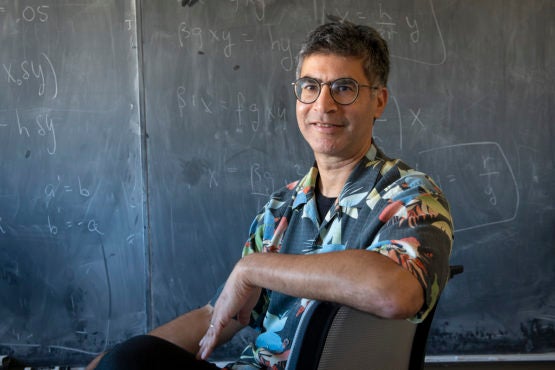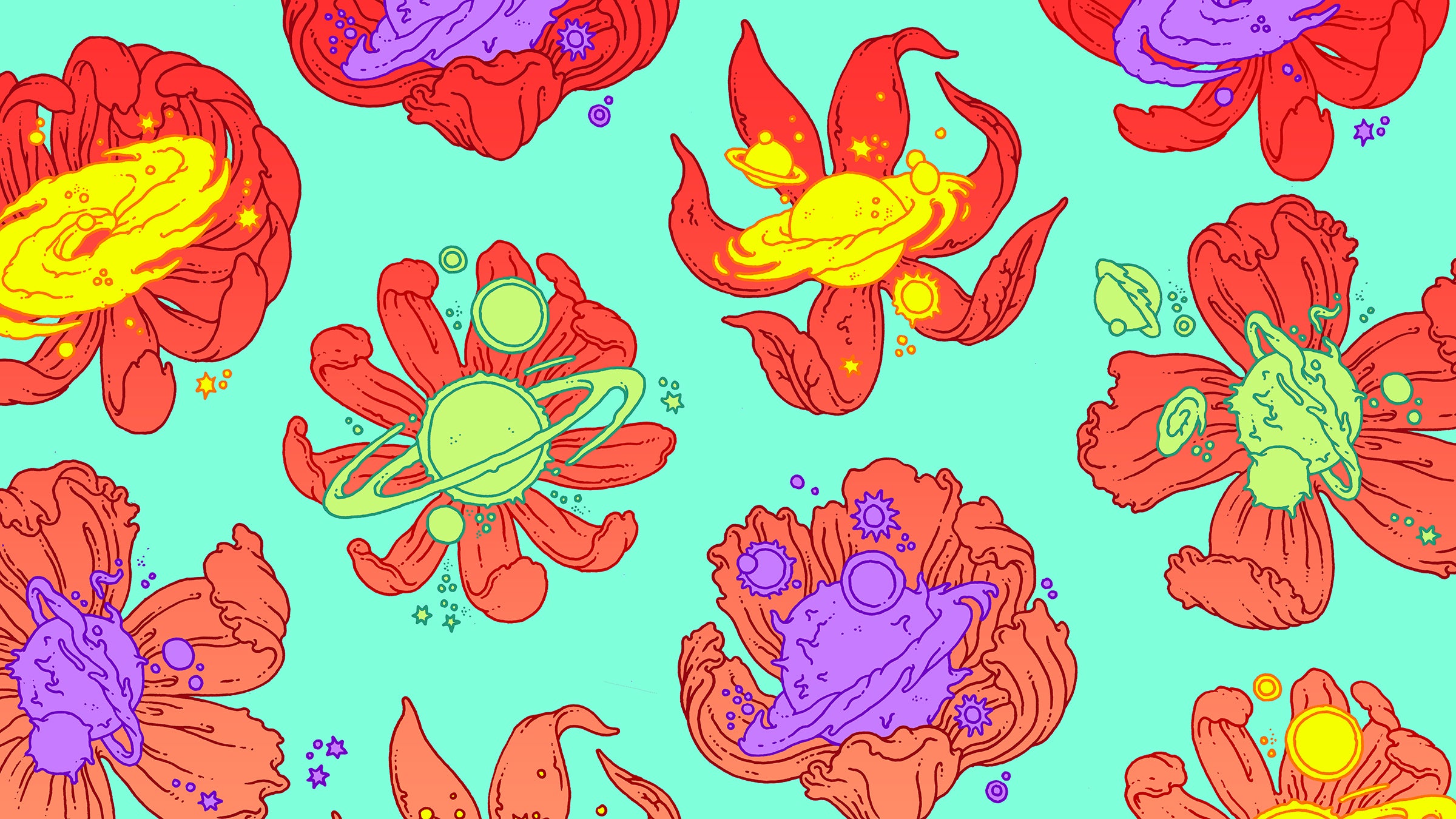The fractal universe
Late one summer night nearly 40 years ago, Andrei Linde was seized by a sudden conviction that he knew how the universe was born. His nocturnal eureka moment would lead to the concept of a multiverse, a central part of the String Theory Landscape. This story is part 3 of a five-part series.
Late one summer night in 1981, while still a junior research fellow at Lebedev Physical Institute in Moscow, Andrei Linde was struck by a revelation. Unable to contain his excitement, he shook awake his wife, Renata Kallosh, and whispered to her in their native Russian, “I think I know how the universe was born.”
Kallosh, a theoretical physicist herself, muttered some encouraging words and fell back asleep. “It wasn’t until the next morning that I realized the full impact of what Andrei had told me,” recalled Kallosh, now a professor of physics at the Stanford Institute for Theoretical Physics.
Linde’s nocturnal eureka moment had to do with a problem in cosmology that he and other theorists, including Stephen Hawking, had struggled with for months.
A year earlier, a 32-year-old postdoc at SLAC National Accelerator Laboratory named Alan Guth shocked the physics community by proposing a bold modification to the Big Bang theory. According to Guth’s idea, which he called “inflation,” our universe erupted from a vacuum-like state and underwent a brief period of faster-than-light expansion. In less than a billionth of a trillionth of a trillionth of a second, space-time doubled more than 60 times from a subatomic speck to a volume many times larger than the observable universe.
Guth envisioned the powerful repulsive force fueling the universe’s exponential growth as a field of energy flooding space. As the universe unfurled, this “inflaton field” decayed, and its shed energy was transfigured into a fiery bloom of matter and radiation. This pivot, from nothing to something and timelessness to time, marked the beginning of the Big Bang. It also prompted Guth to famously quip that the inflationary universe was the “ultimate free lunch.”
As theories go, inflation was a beauty. It explained in one fell swoop why the universe is so large, why it was born hot, and why its structure appears to be so flat and uniform over vast distances. There was just one problem – it didn’t work.
Tunneling
To conclude the unpacking of space-time, Guth borrowed a trick from quantum mechanics called “tunneling” to allow his inflaton field to randomly and instantly skip from a higher, less stable energy state to a lower one, thus bypassing a barrier that could not be scaled by classical physics.

Andrei Linde and Renata Kallosh, both professors of physics. (Image credit: L.A. Cicero)
But closer inspection revealed that quantum tunneling caused the inflaton field to decay quickly and unevenly, resulting in a universe that was neither flat nor uniform. Aware of the fatal flaw in his theory, Guth wrote at the end of his paper on inflation: “I am publishing this paper in the hope that it will … encourage others to find some way to avoid the undesirable features of the inflationary scenario.”
Guth’s plea was answered by Linde, who on that fateful summer night realized that inflation didn’t require quantum tunneling to work. Instead, the inflaton field could be modeled as a ball rolling down a hill of potential energy that had a very shallow, nearly flat slope. While the ball rolls lazily downhill, the universe is inflating, and as it nears the bottom, inflation slows further and eventually ends. This provided a “graceful exit” to the inflationary state that was lacking in Guth’s model and produced a cosmos like the one we observe. To distinguish it from Guth’s original model while still paying homage to it, Linde dubbed his model “new inflation.”
Quantum birth of galaxies
By the time Linde and Kallosh moved to Stanford in 1990, experiments had begun to catch up with the theory. Space missions were finding temperature variations in the energetic afterglow of the Big Bang – called the cosmic microwave background radiation – that confirmed a startling prediction made by the latest inflationary models. These updated models went by various names – “chaotic inflation,” “eternal inflation,” “eternal chaotic inflation” and many more – but they all shared in common the graceful exit that Linde pioneered.
“The inflationary universe is not just the ultimate free lunch, it’s the only lunch where all possible dishes are served.”
—Andrei Linde
Professor of Physics
According to these models, galaxies like the Milky Way grew from faint wrinkles in the fabric of space-time. The density of matter in these wrinkles was slightly greater compared to surrounding areas and this difference was magnified during inflation, allowing them to attract even more matter. From these dense primordial seeds grew the cosmic structures we see today. “Galaxies are children of random quantum fluctuations produced during the first 10-35 seconds after the birth of the universe,” Linde said.
Inflation predicted that these quantum fluctuations would leave imprints on the universe’s background radiation in the form of hotter and colder regions, and this is precisely what two experiments – dubbed COBE and WMAP – found. “After the COBE and WMAP experiments, inflation started to become part of the standard model of cosmology,” Shamit Kachru said.
The multiverse
Linde and others later realized that the same quantum fluctuations that produced galaxies can give rise to new inflating regions in the universe. Even though inflation ended in our local cosmic neighborhood 14 billion years ago, it can still continue at the outermost fringes of the universe. The consequence is an ever-expanding sea of inflating space-time dotted with “island universes” or “pocket universes” like our own where inflation has ceased. “As a result, the universe becomes a multiverse, an eternally growing fractal consisting of exponentially many exponentially large parts,” Linde wrote. “These parts are so large that for all practical purposes they look like separate universes.”

Shamit Kachru, Professor of Physics and Director, Stanford Institute for Theoretical Physics (Image credit: L.A. Cicero)
Linde took the multiverse idea even further by proposing that each pocket universe could have differing properties, a conclusion that some string theorists were also reaching independently. “It’s not that the laws of physics are different in each universe, but their realizations,” Linde said. “An analogy is the relationship between liquid water and ice. They’re both H2O but realized differently.”
Linde’s multiverse is like a cosmic funhouse filled with reality-distorting mirrors. Some pocket universes are resplendent with life, while others were stillborn because they were cursed with too few (or too many) dimensions, or with physics incompatible with the formation of stars and galaxies. An infinite number are exact replicas of ours, but infinitely more are only near-replicas. Right now, there could be countless versions of you inhabiting worlds with histories divergent from ours in ways large and small. In an infinitely expanding multiverse, anything that can happen will happen.
“The inflationary universe is not just the ultimate free lunch, it’s the only lunch where all possible dishes are served,” Linde said.
While disturbing to some, this eternal aspect of inflation was just what a small group of string theorists were looking for to help explain a surprise discovery that was upending the physics world – dark energy.

